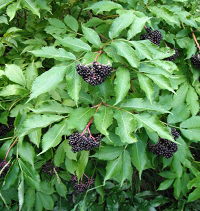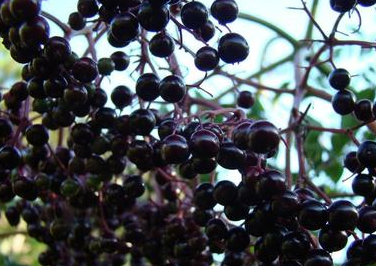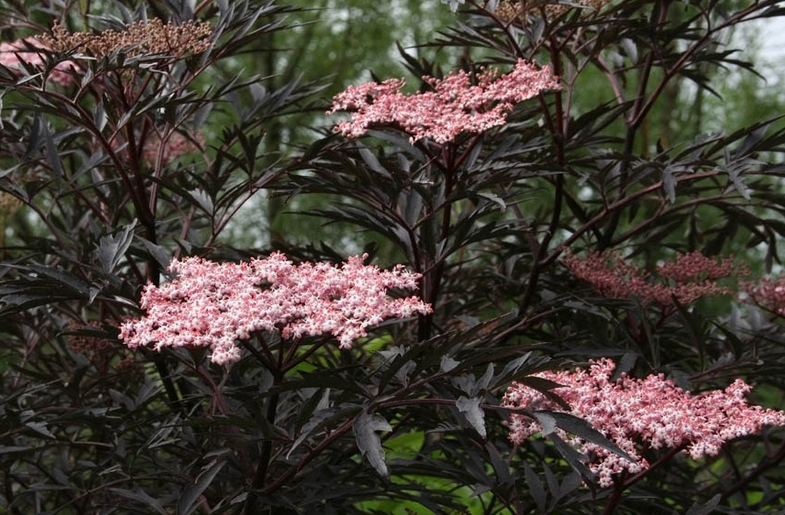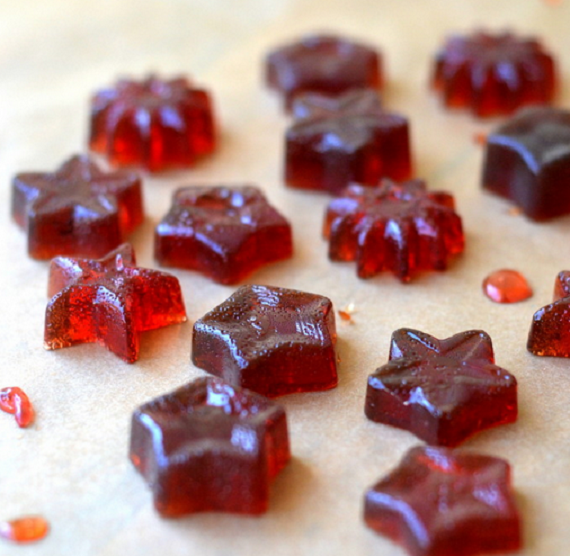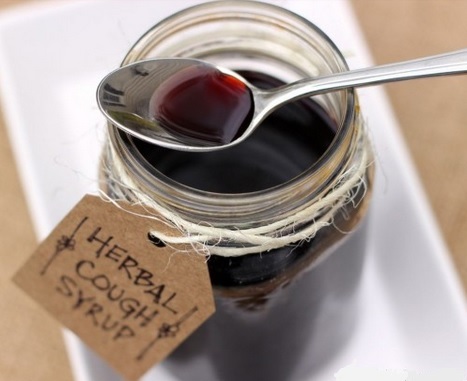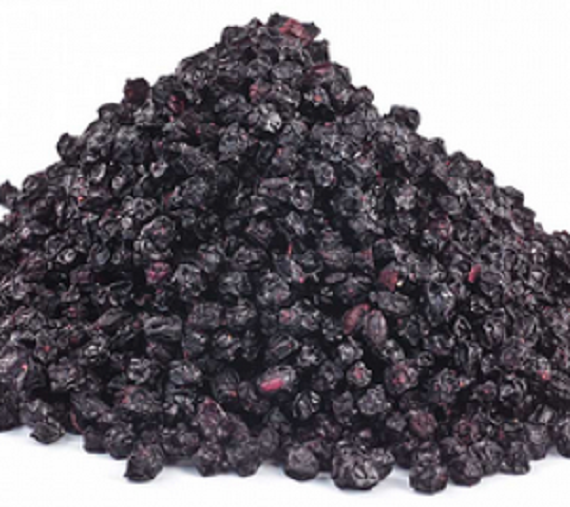 Loading... Please wait...
Loading... Please wait...Elderberries are in season!
Posted by Patricia Delgado on 2nd Oct 2015
Elderberries (Sambucus caerulea) are found in
our little town of
On our farmstead we cultivate the Sambucus nigra 'Black Lace', Black Lace Elderberry which we harvested nearly 25 pounds, froze about 4 lbs for making Elderberry cough syrup and cough drops this winter, and the remainder was sun dried and packaged for my Mountain Maus Remedies customers.
The wild trees we picked from were the species Sambucus caerulea, known as “blue elderberry. These trees grow to about 30 feet high and have dark purple berries that look grayish-blue because of a light waxy coating that covers them. The flowers are white or cream in color, on umbels that are nearly flat across the top when you turn them sideways. They are not as pleasantly smelling as the Sambucus Nigra species.
The Sambucus Nigra species we cultivate for its medicinal value are pruned into bushes for easy harvest. The berries are a glossy dark purple to black.The hermaphrodite flowers are borne in large, flat corymbs in late spring to mid summer, the flowers are an ivory white to light purple and are very fragrant.
The common elderberry is very abundant in this area. They are everywhere! We drove down old logging trails and walked what seemed like miles to small open wild areas. Every 15-20 feet we would come upon another elderberry tree! Watching my husband climb these trees was a site to see. It was impossible to pick all the elderberries we could see. Plus, the bushes grew so tall, we could only harvest the lowest 4 or 6 feet. We made sure we left enough berries for the birds and wildlife to enjoy.
If you’re lucky enough to have elderberries growing in your area, look for them along less-traveled roads and secluded areas. Elderberries love lots of sunlight and its best not to pick them along well-traveled roads because of all the pollutants near major roadways, from exhaust, weed sprays, etc. have likely contaminated plants in those areas. A helpful note Elderberries do contain poisonous cyanic compounds contained in the stems, leaves, roots, and seeds. The berries are edible when they’re ripe and cooked. A handful of uncooked elderberries probably wont hurt you, but if you eat too many, especially on an empty stomach, you’ll likely get ill. The flowers are also edible, and have also traditionally been used to lightly flavor fritters, pancakes, scones, and cakes.
Below are some helpful tidbits of the Medicinal Sambucus Nigra that is available on my shop. This October I will start making cough drops and cough syrup (made to order). Yummm!!! Just in time for the cold and flu season. So make sure you put your order in while supplies last.
The Sambucus Nigra berries are used for its antioxidant activity to lower cholesterol, improve vision, boost the immune system, improve heart health and for coughs, colds, flu, bacterial and viral infections and even tonsillitis.
Bioflavonoids and other proteins in the juice destroy the ability of cold and flu viruses to infect a cell. People with the flu who took elderberry juice reported less severe symptoms and felt better much faster than those who did not.
Beneficial components in Elderberries
Elderberries contain organic pigments, tannin, amino acids, carotenoids, flavonoids, sugar, rutin, viburnic acid,vitaman A and B and a large amount of vitamin C. They are also mildly laxative, a diuretic, and diaphoretic. Flavonoids, including quercetin, are believed to account for the therapeutic actions of the elderberry flowers and berries. According to test tube studies these flavonoids include anthocyanins that are powerful antioxidants and protect cells against damage.
Health Benefits of Elderberries
Elderberries were listed in the CRC Handbook of Medicinal Herbs
as early as 1985, and are listed in the 2000 Mosby's Nursing Drug reference for
colds, flu, yeast infections, nasal and chest congestion, and hay fever. In
At the Bundesforschungsanstalt (try saying that
3 times in a row) research center for food in
Studies at Austria's University of Graz found that elderberry extract reduces oxidation of low-density lipoprotein (LDL) cholesterol. Oxidation of LDL cholesterol is implicated in atherogenesis, thus contributing to cardiovascular disease.
The flowers of the Elder is often overlooked for its medicinal benefits and is most frequently used for its flavoring properties and in making various foods and beverages. Both the flowers and berries in the Elder plant can be used when properly prepared, but all leaves, sticks, and roots should be avoided.
Health Benefits of Elderflower
Elderflower has been used in traditional medicine all over the world in many different cultures due to its antiseptic and anti-inflammatory properties. The most common uses are for colds and flu, sinus infections, and other respiratory disturbances. As a supplement, elderflower also has diuretic and laxative properties and is helpful in relieving occasional constipation. Elderflower has antibacterial and antiviral properties and may also help alleviate some allergies and boost the functioning of the immune system. Topically, elderflower helps to reduce pain and swelling in joints due to some forms of arthritis and is used to stop bleeding. As an oral rinse, elderflower can be used for its antiseptic properties as a mouthwash and gargle. Elderflower also reduces blood sugar levels, very similar to the way insulin works.
Elderflower against MSRA
Research in
Active Ingredients in Elderflower
Elderflower is rich in bioflavonoids, mostly flavones and flavonols, that are most commonly known for their antioxidant. anti-cancer, anti-inflammatory and antibacterial properties. The most abundant flavonols in elderflower are quercetin, isoquercitrin and anthocyanins, which have antiviral properties as well. Elderflower also contains chlorogenic acids, such as cinnamic acid, which may help with allergies, regulate blood glucose levels and have a laxative effect on the body. Triterpenoids, especially β-amyrin, erythrodiol, and oleanolic acid, are also found in elderflower. These triterpenoids offer a variety of health benefits including analgesic, anti-inflammatory, and anti-cancer effects.
Remember flu season is upon us, so get your elderberry cough drops and cough syrup before my supplies run out. I also have other cold remedies in teas and tinctures.
If you would like to make your own Elderberry cough syrup here's my recipe.
You Will Need:
- 1/2 cup of dried Elderberries
- 3 cups water
- 1 cup Raw honey (preferably local)
- 1 organic cinnamon stick
- 2 or 3 dried cloves
- And an optional pinch of dried ginger root powder
Directions:
- Put all the ingredients except the honey into a pot and bring it to a boil.
- Reduce heat and simmer for 30 minutes.
- Squish the mixture through a strainer and let cool.
- Once cool, mix in your raw honey.
How to Use:
This will last 2-3 months in the fridge. Take a tablespoon every day to prevent colds and flus. If you get sick you can take a teaspoon every 2-3 hours while sick.
This is about it for this weeks foraging, I will squeak at you next week with a new entry.

